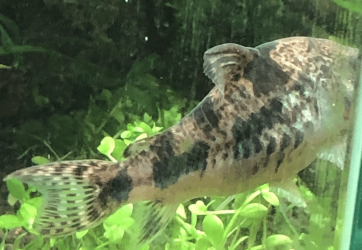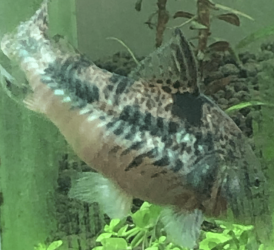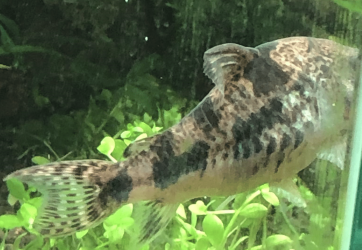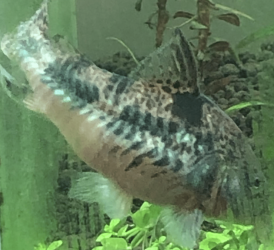Tank size: 64L
pH: 5.9-6.4
ammonia: 0
nitrite: 0
nitrate: 20
kH: 2
gH: nil
tank temp: 25 degrees celsius
Fish Symptoms (include full description including lesion, color, location, fish behavior):
First noticed it inside the tank 5 days ago but fished it out recently when rescaping hardscape and got a better look at it from above the fish. Localised growth/lump on the right lower aspect of the Peppered Cory, appears to be unilateral only/left side appears normal(?). No meds added yet, fish was born and raised in the tank. Behaviour appears normal, appearance as described above, please find attached photos below (I apologise, there are no side on shots, in hindsight I should have netted it and snapped it).
Volume and Frequency of water changes: 64L, weekly WC
Chemical Additives or Media in your tank: Fertiliser added 2x weekly, initially used stability to cycle
Tank inhabitants: 3 peppered, 2 bronze, 2 panda corydoras
Recent additions to your tank (living or decoration): nil
Exposure to chemicals: Aside from above liquid fertiliser, nothing of note.
I first noticed this peppered cory cat exhibiting this bulge on its lower right abdomen recently but did not take much notice as I thought it was likely bilateral and the opposite side showing similar pattern. However today I was rescaping the tank and had to remove all fish and found that this abnormality was only found on its right side. It is still capable of swimming and eating normally. I thought it may have been due to indigestion and proceeded to place some de-shelled peas inside the tank but all cories refused to pay attention as they're accustomed to more protein options. Another differential diagnosis is dropsy however I've only seen it in my guppies and they it appeared to be diffuse as opposed to being contained to one side.
pH: 5.9-6.4
ammonia: 0
nitrite: 0
nitrate: 20
kH: 2
gH: nil
tank temp: 25 degrees celsius
Fish Symptoms (include full description including lesion, color, location, fish behavior):
First noticed it inside the tank 5 days ago but fished it out recently when rescaping hardscape and got a better look at it from above the fish. Localised growth/lump on the right lower aspect of the Peppered Cory, appears to be unilateral only/left side appears normal(?). No meds added yet, fish was born and raised in the tank. Behaviour appears normal, appearance as described above, please find attached photos below (I apologise, there are no side on shots, in hindsight I should have netted it and snapped it).
Volume and Frequency of water changes: 64L, weekly WC
Chemical Additives or Media in your tank: Fertiliser added 2x weekly, initially used stability to cycle
Tank inhabitants: 3 peppered, 2 bronze, 2 panda corydoras
Recent additions to your tank (living or decoration): nil
Exposure to chemicals: Aside from above liquid fertiliser, nothing of note.
I first noticed this peppered cory cat exhibiting this bulge on its lower right abdomen recently but did not take much notice as I thought it was likely bilateral and the opposite side showing similar pattern. However today I was rescaping the tank and had to remove all fish and found that this abnormality was only found on its right side. It is still capable of swimming and eating normally. I thought it may have been due to indigestion and proceeded to place some de-shelled peas inside the tank but all cories refused to pay attention as they're accustomed to more protein options. Another differential diagnosis is dropsy however I've only seen it in my guppies and they it appeared to be diffuse as opposed to being contained to one side.
Attachments
Last edited:







![IMG_4039[3830].jpg IMG_4039[3830].jpg](https://www.fishforums.net/data/attachments/88/88767-459de8467ef54a021678e781d410ba4c.jpg)
![IMG_4071[3818].jpg IMG_4071[3818].jpg](https://www.fishforums.net/data/attachments/88/88766-ba68068c405551322e3d63bdfbc5f3fb.jpg)

